Chronic Kidney Disease Management and Research
VerifiedAdded on 2020/10/22
|14
|5832
|220
AI Summary
The provided document contains a list of references to articles and studies related to chronic kidney disease (CKD) management and research. The references cover topics such as palliative care in CKD patients, renal replacement therapy, iron deficiency diagnosis and management, mesenchymal stromal cells in renal transplantation, metabolic syndrome and kidney stone disease, and factors associated with CKD self-management. This document appears to be a collection of academic sources for students researching CKD, likely intended for publication on Desklib as a resource for past papers and solved assignments.
Contribute Materials
Your contribution can guide someone’s learning journey. Share your
documents today.
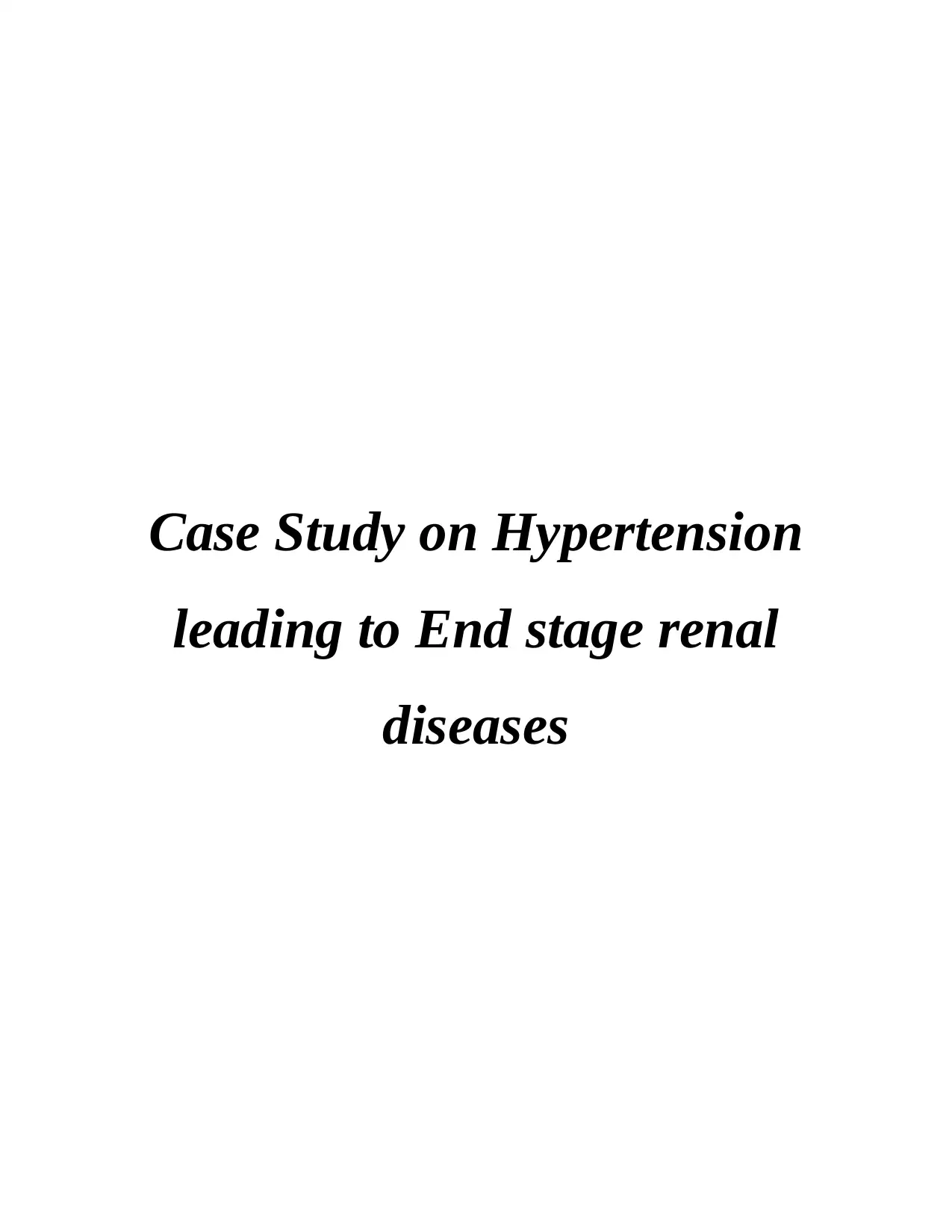
Case Study on Hypertension
leading to End stage renal
diseases
leading to End stage renal
diseases
Secure Best Marks with AI Grader
Need help grading? Try our AI Grader for instant feedback on your assignments.
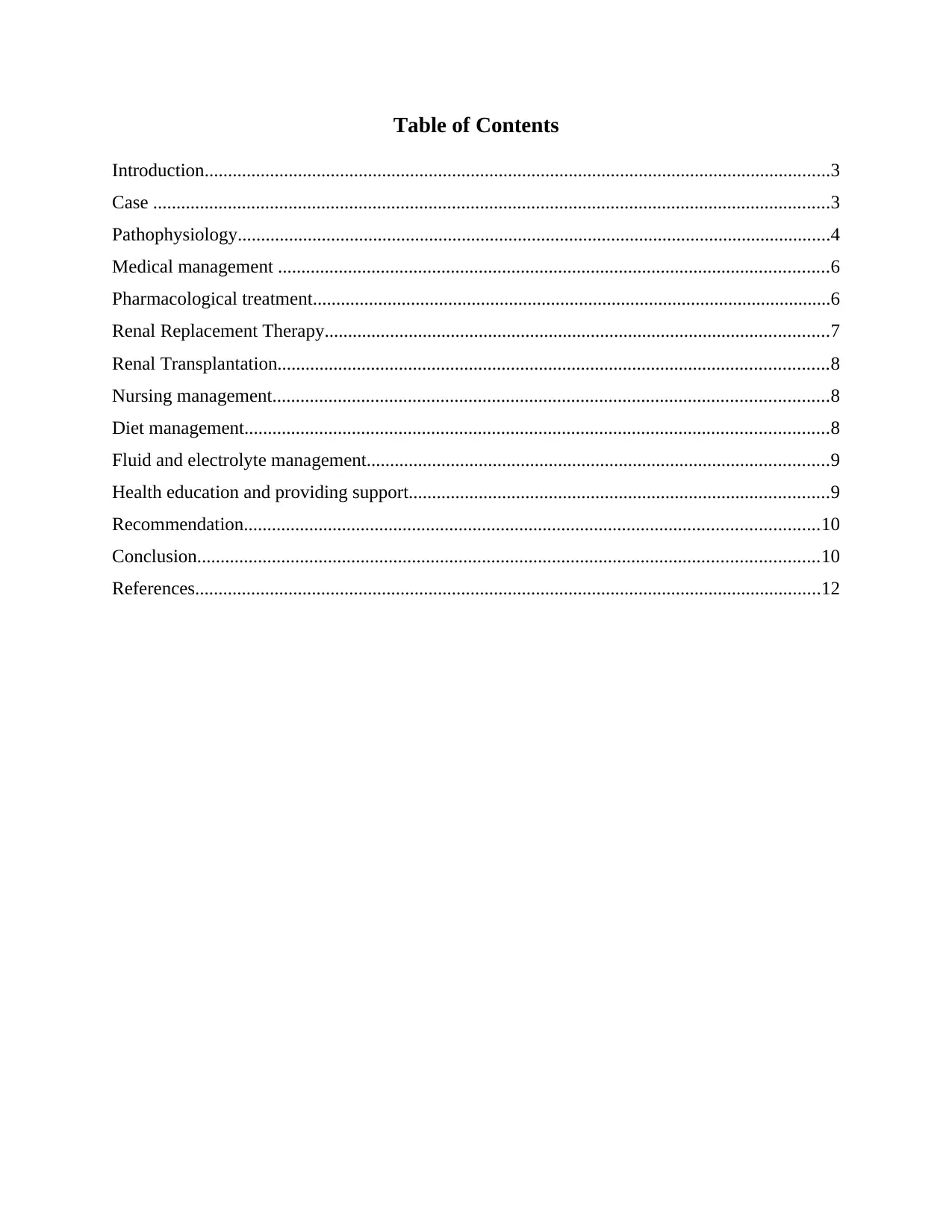
Table of Contents
Introduction......................................................................................................................................3
Case .................................................................................................................................................3
Pathophysiology...............................................................................................................................4
Medical management ......................................................................................................................6
Pharmacological treatment...............................................................................................................6
Renal Replacement Therapy............................................................................................................7
Renal Transplantation......................................................................................................................8
Nursing management.......................................................................................................................8
Diet management.............................................................................................................................8
Fluid and electrolyte management...................................................................................................9
Health education and providing support..........................................................................................9
Recommendation...........................................................................................................................10
Conclusion.....................................................................................................................................10
References......................................................................................................................................12
Introduction......................................................................................................................................3
Case .................................................................................................................................................3
Pathophysiology...............................................................................................................................4
Medical management ......................................................................................................................6
Pharmacological treatment...............................................................................................................6
Renal Replacement Therapy............................................................................................................7
Renal Transplantation......................................................................................................................8
Nursing management.......................................................................................................................8
Diet management.............................................................................................................................8
Fluid and electrolyte management...................................................................................................9
Health education and providing support..........................................................................................9
Recommendation...........................................................................................................................10
Conclusion.....................................................................................................................................10
References......................................................................................................................................12
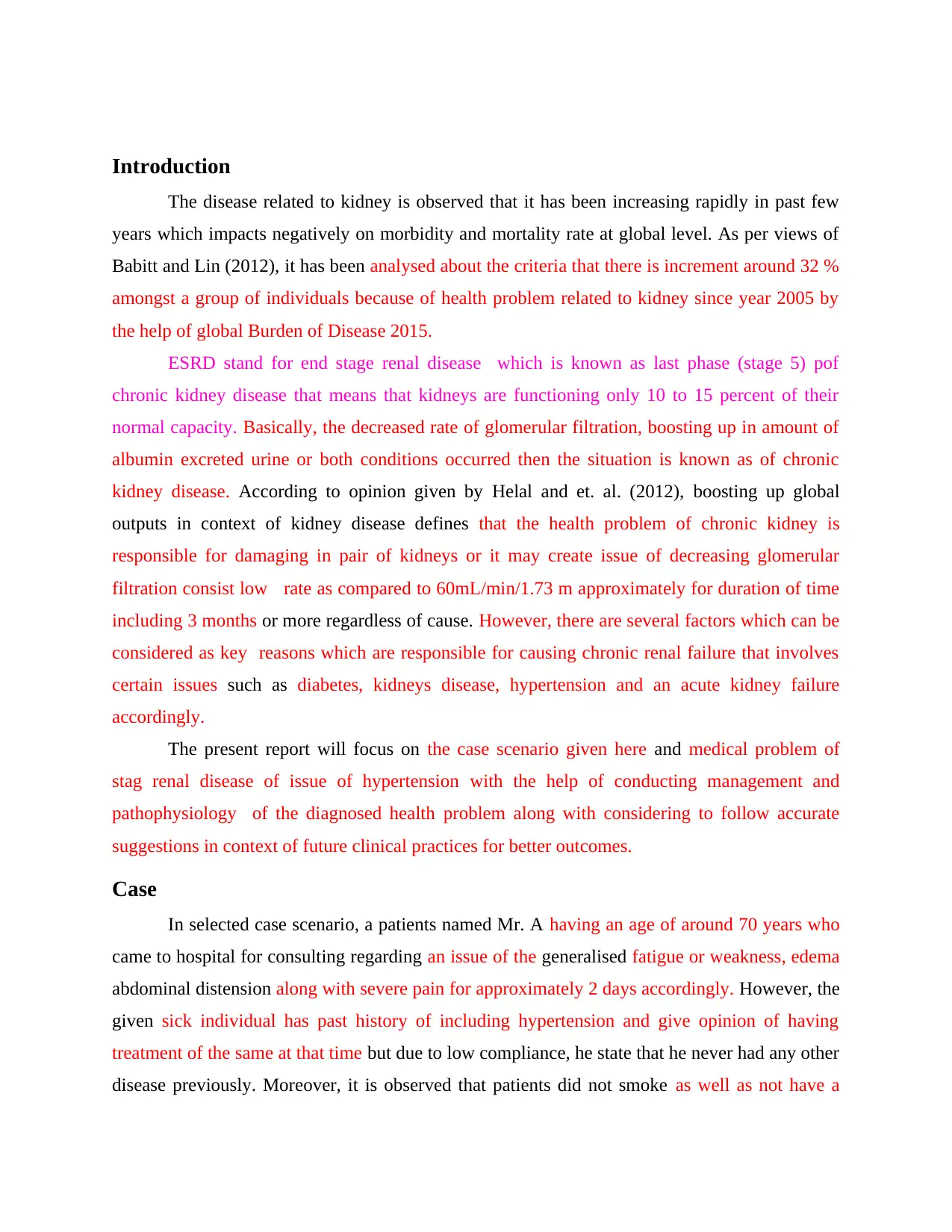
Introduction
The disease related to kidney is observed that it has been increasing rapidly in past few
years which impacts negatively on morbidity and mortality rate at global level. As per views of
Babitt and Lin (2012), it has been analysed about the criteria that there is increment around 32 %
amongst a group of individuals because of health problem related to kidney since year 2005 by
the help of global Burden of Disease 2015.
ESRD stand for end stage renal disease which is known as last phase (stage 5) pof
chronic kidney disease that means that kidneys are functioning only 10 to 15 percent of their
normal capacity. Basically, the decreased rate of glomerular filtration, boosting up in amount of
albumin excreted urine or both conditions occurred then the situation is known as of chronic
kidney disease. According to opinion given by Helal and et. al. (2012), boosting up global
outputs in context of kidney disease defines that the health problem of chronic kidney is
responsible for damaging in pair of kidneys or it may create issue of decreasing glomerular
filtration consist low rate as compared to 60mL/min/1.73 m approximately for duration of time
including 3 months or more regardless of cause. However, there are several factors which can be
considered as key reasons which are responsible for causing chronic renal failure that involves
certain issues such as diabetes, kidneys disease, hypertension and an acute kidney failure
accordingly.
The present report will focus on the case scenario given here and medical problem of
stag renal disease of issue of hypertension with the help of conducting management and
pathophysiology of the diagnosed health problem along with considering to follow accurate
suggestions in context of future clinical practices for better outcomes.
Case
In selected case scenario, a patients named Mr. A having an age of around 70 years who
came to hospital for consulting regarding an issue of the generalised fatigue or weakness, edema
abdominal distension along with severe pain for approximately 2 days accordingly. However, the
given sick individual has past history of including hypertension and give opinion of having
treatment of the same at that time but due to low compliance, he state that he never had any other
disease previously. Moreover, it is observed that patients did not smoke as well as not have a
The disease related to kidney is observed that it has been increasing rapidly in past few
years which impacts negatively on morbidity and mortality rate at global level. As per views of
Babitt and Lin (2012), it has been analysed about the criteria that there is increment around 32 %
amongst a group of individuals because of health problem related to kidney since year 2005 by
the help of global Burden of Disease 2015.
ESRD stand for end stage renal disease which is known as last phase (stage 5) pof
chronic kidney disease that means that kidneys are functioning only 10 to 15 percent of their
normal capacity. Basically, the decreased rate of glomerular filtration, boosting up in amount of
albumin excreted urine or both conditions occurred then the situation is known as of chronic
kidney disease. According to opinion given by Helal and et. al. (2012), boosting up global
outputs in context of kidney disease defines that the health problem of chronic kidney is
responsible for damaging in pair of kidneys or it may create issue of decreasing glomerular
filtration consist low rate as compared to 60mL/min/1.73 m approximately for duration of time
including 3 months or more regardless of cause. However, there are several factors which can be
considered as key reasons which are responsible for causing chronic renal failure that involves
certain issues such as diabetes, kidneys disease, hypertension and an acute kidney failure
accordingly.
The present report will focus on the case scenario given here and medical problem of
stag renal disease of issue of hypertension with the help of conducting management and
pathophysiology of the diagnosed health problem along with considering to follow accurate
suggestions in context of future clinical practices for better outcomes.
Case
In selected case scenario, a patients named Mr. A having an age of around 70 years who
came to hospital for consulting regarding an issue of the generalised fatigue or weakness, edema
abdominal distension along with severe pain for approximately 2 days accordingly. However, the
given sick individual has past history of including hypertension and give opinion of having
treatment of the same at that time but due to low compliance, he state that he never had any other
disease previously. Moreover, it is observed that patients did not smoke as well as not have a
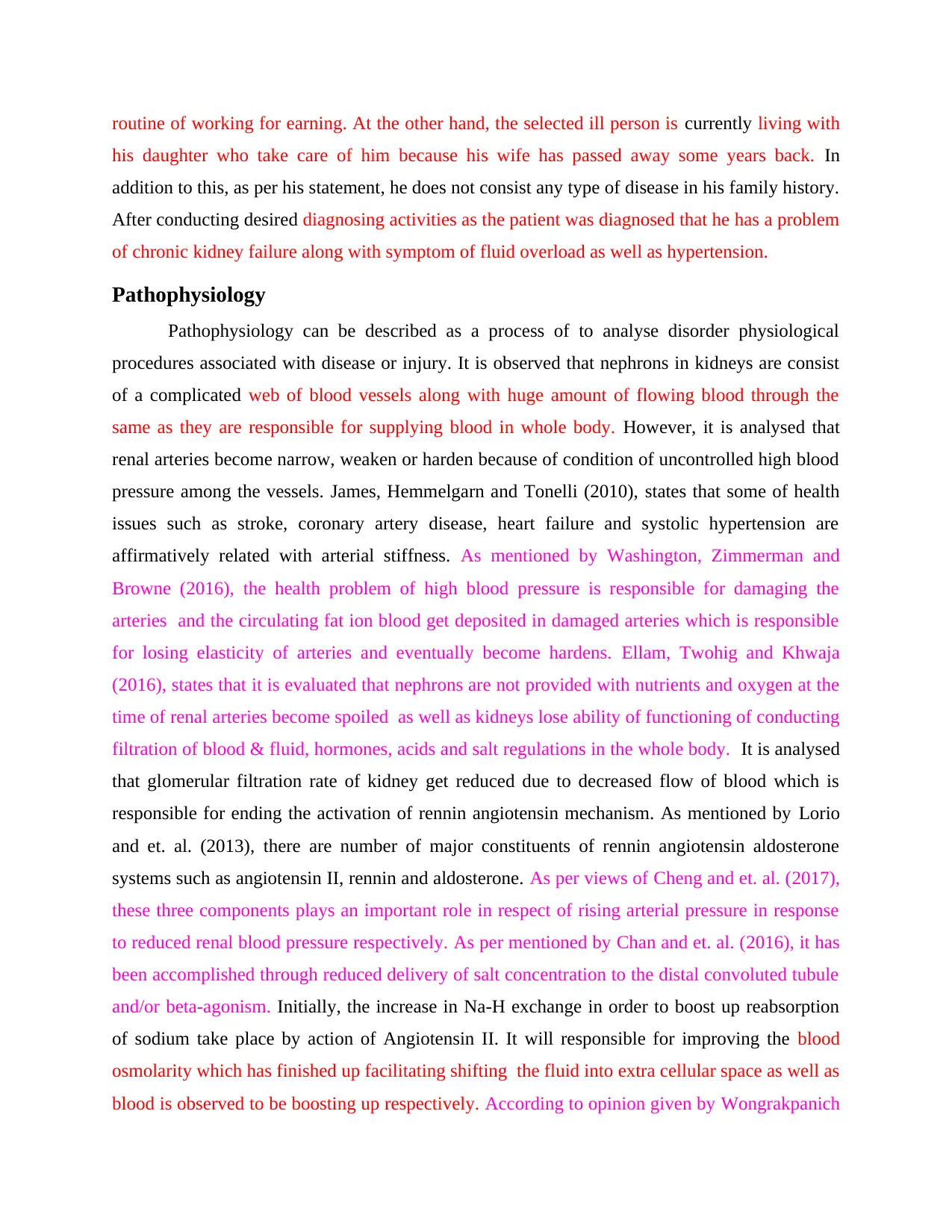
routine of working for earning. At the other hand, the selected ill person is currently living with
his daughter who take care of him because his wife has passed away some years back. In
addition to this, as per his statement, he does not consist any type of disease in his family history.
After conducting desired diagnosing activities as the patient was diagnosed that he has a problem
of chronic kidney failure along with symptom of fluid overload as well as hypertension.
Pathophysiology
Pathophysiology can be described as a process of to analyse disorder physiological
procedures associated with disease or injury. It is observed that nephrons in kidneys are consist
of a complicated web of blood vessels along with huge amount of flowing blood through the
same as they are responsible for supplying blood in whole body. However, it is analysed that
renal arteries become narrow, weaken or harden because of condition of uncontrolled high blood
pressure among the vessels. James, Hemmelgarn and Tonelli (2010), states that some of health
issues such as stroke, coronary artery disease, heart failure and systolic hypertension are
affirmatively related with arterial stiffness. As mentioned by Washington, Zimmerman and
Browne (2016), the health problem of high blood pressure is responsible for damaging the
arteries and the circulating fat ion blood get deposited in damaged arteries which is responsible
for losing elasticity of arteries and eventually become hardens. Ellam, Twohig and Khwaja
(2016), states that it is evaluated that nephrons are not provided with nutrients and oxygen at the
time of renal arteries become spoiled as well as kidneys lose ability of functioning of conducting
filtration of blood & fluid, hormones, acids and salt regulations in the whole body. It is analysed
that glomerular filtration rate of kidney get reduced due to decreased flow of blood which is
responsible for ending the activation of rennin angiotensin mechanism. As mentioned by Lorio
and et. al. (2013), there are number of major constituents of rennin angiotensin aldosterone
systems such as angiotensin II, rennin and aldosterone. As per views of Cheng and et. al. (2017),
these three components plays an important role in respect of rising arterial pressure in response
to reduced renal blood pressure respectively. As per mentioned by Chan and et. al. (2016), it has
been accomplished through reduced delivery of salt concentration to the distal convoluted tubule
and/or beta-agonism. Initially, the increase in Na-H exchange in order to boost up reabsorption
of sodium take place by action of Angiotensin II. It will responsible for improving the blood
osmolarity which has finished up facilitating shifting the fluid into extra cellular space as well as
blood is observed to be boosting up respectively. According to opinion given by Wongrakpanich
his daughter who take care of him because his wife has passed away some years back. In
addition to this, as per his statement, he does not consist any type of disease in his family history.
After conducting desired diagnosing activities as the patient was diagnosed that he has a problem
of chronic kidney failure along with symptom of fluid overload as well as hypertension.
Pathophysiology
Pathophysiology can be described as a process of to analyse disorder physiological
procedures associated with disease or injury. It is observed that nephrons in kidneys are consist
of a complicated web of blood vessels along with huge amount of flowing blood through the
same as they are responsible for supplying blood in whole body. However, it is analysed that
renal arteries become narrow, weaken or harden because of condition of uncontrolled high blood
pressure among the vessels. James, Hemmelgarn and Tonelli (2010), states that some of health
issues such as stroke, coronary artery disease, heart failure and systolic hypertension are
affirmatively related with arterial stiffness. As mentioned by Washington, Zimmerman and
Browne (2016), the health problem of high blood pressure is responsible for damaging the
arteries and the circulating fat ion blood get deposited in damaged arteries which is responsible
for losing elasticity of arteries and eventually become hardens. Ellam, Twohig and Khwaja
(2016), states that it is evaluated that nephrons are not provided with nutrients and oxygen at the
time of renal arteries become spoiled as well as kidneys lose ability of functioning of conducting
filtration of blood & fluid, hormones, acids and salt regulations in the whole body. It is analysed
that glomerular filtration rate of kidney get reduced due to decreased flow of blood which is
responsible for ending the activation of rennin angiotensin mechanism. As mentioned by Lorio
and et. al. (2013), there are number of major constituents of rennin angiotensin aldosterone
systems such as angiotensin II, rennin and aldosterone. As per views of Cheng and et. al. (2017),
these three components plays an important role in respect of rising arterial pressure in response
to reduced renal blood pressure respectively. As per mentioned by Chan and et. al. (2016), it has
been accomplished through reduced delivery of salt concentration to the distal convoluted tubule
and/or beta-agonism. Initially, the increase in Na-H exchange in order to boost up reabsorption
of sodium take place by action of Angiotensin II. It will responsible for improving the blood
osmolarity which has finished up facilitating shifting the fluid into extra cellular space as well as
blood is observed to be boosting up respectively. According to opinion given by Wongrakpanich
Secure Best Marks with AI Grader
Need help grading? Try our AI Grader for instant feedback on your assignments.

and et. al. (2017), the stimulation about excretion of the potassium and reabsorption of sodium
upon the collecting ducts as well as distal tubules through the support of released aldosterone
accordingly. It will also plays an important role for increasing sodium reabsorption results into
increase in arterial blood pressure. Apart from this, the angiotensin also has an impact on
vasoconstriction that facilitate to improve blood pressure further. With the help such
mechanisms, the human body can increase its blood pressure in an elongated way. According to
the views given by Palatini and et. al. (2011), the given mechanism has a function to increase
blood pressure through boosting up reabsorption of sodium, water reabsorption and vascular
tone. Moreover, it will provide support to constrict blood vessels and increasing the heart rate
along with blood pressure. Meanwhile, it is analysed that over the time stenosis increases that
ends up with glomerulosclerosis. Furthermore, it will facilitate ability to function of membrane
due to he limitation in supply of blood. It has been evaluated that blood flow get shifted towards
damaged nephrons at the time when they loose their functioning which will results into
glomerular hyper filtration. Pena and et. al. (2014), states that glomerular hyper filtration can be
described about a condition of abnormally high overall glomerular filtrate rate of kidney.
Boosted up rate of filtration or the improved phenomena of filtration per nephron that is unit of
kidneys. It is observed that glomerular filtrate increase the performing ability of nephrons at the
beginning but over the duration of time in which these nephrons are responsible for generating
phenomena of glomerusclerosis that facilitate the irreversible loss of nephrons respectively.
(Mancia and et. al., 2014). As per views given by Wukich and et. al. (2017), due to continuity of
this situation then it ends up with reduce Glomerular Filtration rate, decrease urine outputs along
with uremia. This kind of damage is responsible for occurring problem in sodium and water
balance as reduction in Glomerular filtration rate that results into retention of salt as well as
water. Knoll and et. al. (2016), States that it will facilitate the increase in blood pressure and
peripheral edema. However, increase of potassium take place due to reduced Glomerular
filtration rate which lead to hypokalaemia ends up with the patients consisting certain problems
including ECG changes, muscle weakness and fibrillations. It has been analysed that damaged
nephrons diminishes the capacity of excretion of hydrogen ions and to create bicarbonates which
facilitate the metabolic acidosis. At the other hand, metabolic acidosis may leads to occurrence
of bone decalcification and the mineral balance mechanism get spoiled due to damaged nephron.
Williams (2017) states that kidney is responsible for producing calcitriol hormone which provide
upon the collecting ducts as well as distal tubules through the support of released aldosterone
accordingly. It will also plays an important role for increasing sodium reabsorption results into
increase in arterial blood pressure. Apart from this, the angiotensin also has an impact on
vasoconstriction that facilitate to improve blood pressure further. With the help such
mechanisms, the human body can increase its blood pressure in an elongated way. According to
the views given by Palatini and et. al. (2011), the given mechanism has a function to increase
blood pressure through boosting up reabsorption of sodium, water reabsorption and vascular
tone. Moreover, it will provide support to constrict blood vessels and increasing the heart rate
along with blood pressure. Meanwhile, it is analysed that over the time stenosis increases that
ends up with glomerulosclerosis. Furthermore, it will facilitate ability to function of membrane
due to he limitation in supply of blood. It has been evaluated that blood flow get shifted towards
damaged nephrons at the time when they loose their functioning which will results into
glomerular hyper filtration. Pena and et. al. (2014), states that glomerular hyper filtration can be
described about a condition of abnormally high overall glomerular filtrate rate of kidney.
Boosted up rate of filtration or the improved phenomena of filtration per nephron that is unit of
kidneys. It is observed that glomerular filtrate increase the performing ability of nephrons at the
beginning but over the duration of time in which these nephrons are responsible for generating
phenomena of glomerusclerosis that facilitate the irreversible loss of nephrons respectively.
(Mancia and et. al., 2014). As per views given by Wukich and et. al. (2017), due to continuity of
this situation then it ends up with reduce Glomerular Filtration rate, decrease urine outputs along
with uremia. This kind of damage is responsible for occurring problem in sodium and water
balance as reduction in Glomerular filtration rate that results into retention of salt as well as
water. Knoll and et. al. (2016), States that it will facilitate the increase in blood pressure and
peripheral edema. However, increase of potassium take place due to reduced Glomerular
filtration rate which lead to hypokalaemia ends up with the patients consisting certain problems
including ECG changes, muscle weakness and fibrillations. It has been analysed that damaged
nephrons diminishes the capacity of excretion of hydrogen ions and to create bicarbonates which
facilitate the metabolic acidosis. At the other hand, metabolic acidosis may leads to occurrence
of bone decalcification and the mineral balance mechanism get spoiled due to damaged nephron.
Williams (2017) states that kidney is responsible for producing calcitriol hormone which provide
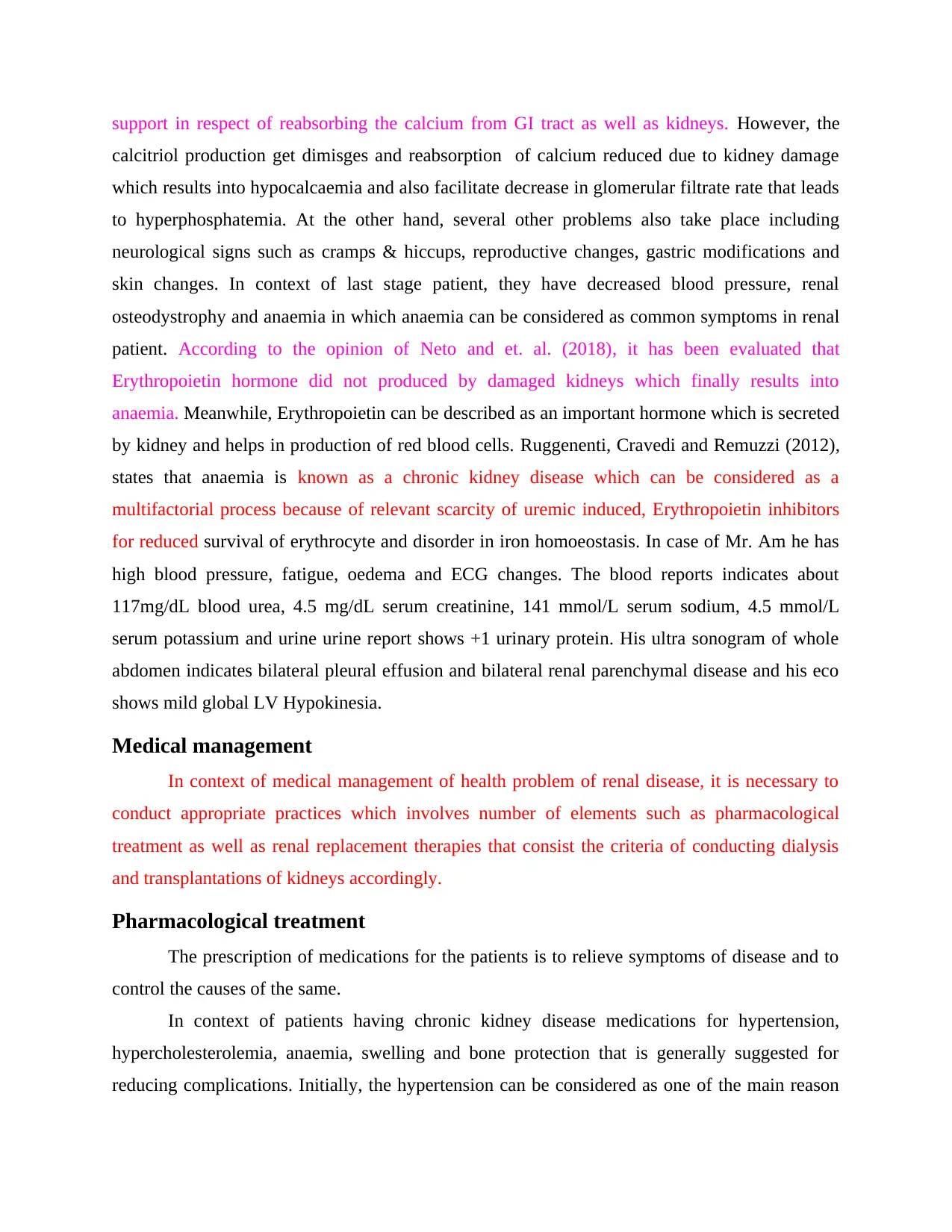
support in respect of reabsorbing the calcium from GI tract as well as kidneys. However, the
calcitriol production get dimisges and reabsorption of calcium reduced due to kidney damage
which results into hypocalcaemia and also facilitate decrease in glomerular filtrate rate that leads
to hyperphosphatemia. At the other hand, several other problems also take place including
neurological signs such as cramps & hiccups, reproductive changes, gastric modifications and
skin changes. In context of last stage patient, they have decreased blood pressure, renal
osteodystrophy and anaemia in which anaemia can be considered as common symptoms in renal
patient. According to the opinion of Neto and et. al. (2018), it has been evaluated that
Erythropoietin hormone did not produced by damaged kidneys which finally results into
anaemia. Meanwhile, Erythropoietin can be described as an important hormone which is secreted
by kidney and helps in production of red blood cells. Ruggenenti, Cravedi and Remuzzi (2012),
states that anaemia is known as a chronic kidney disease which can be considered as a
multifactorial process because of relevant scarcity of uremic induced, Erythropoietin inhibitors
for reduced survival of erythrocyte and disorder in iron homoeostasis. In case of Mr. Am he has
high blood pressure, fatigue, oedema and ECG changes. The blood reports indicates about
117mg/dL blood urea, 4.5 mg/dL serum creatinine, 141 mmol/L serum sodium, 4.5 mmol/L
serum potassium and urine urine report shows +1 urinary protein. His ultra sonogram of whole
abdomen indicates bilateral pleural effusion and bilateral renal parenchymal disease and his eco
shows mild global LV Hypokinesia.
Medical management
In context of medical management of health problem of renal disease, it is necessary to
conduct appropriate practices which involves number of elements such as pharmacological
treatment as well as renal replacement therapies that consist the criteria of conducting dialysis
and transplantations of kidneys accordingly.
Pharmacological treatment
The prescription of medications for the patients is to relieve symptoms of disease and to
control the causes of the same.
In context of patients having chronic kidney disease medications for hypertension,
hypercholesterolemia, anaemia, swelling and bone protection that is generally suggested for
reducing complications. Initially, the hypertension can be considered as one of the main reason
calcitriol production get dimisges and reabsorption of calcium reduced due to kidney damage
which results into hypocalcaemia and also facilitate decrease in glomerular filtrate rate that leads
to hyperphosphatemia. At the other hand, several other problems also take place including
neurological signs such as cramps & hiccups, reproductive changes, gastric modifications and
skin changes. In context of last stage patient, they have decreased blood pressure, renal
osteodystrophy and anaemia in which anaemia can be considered as common symptoms in renal
patient. According to the opinion of Neto and et. al. (2018), it has been evaluated that
Erythropoietin hormone did not produced by damaged kidneys which finally results into
anaemia. Meanwhile, Erythropoietin can be described as an important hormone which is secreted
by kidney and helps in production of red blood cells. Ruggenenti, Cravedi and Remuzzi (2012),
states that anaemia is known as a chronic kidney disease which can be considered as a
multifactorial process because of relevant scarcity of uremic induced, Erythropoietin inhibitors
for reduced survival of erythrocyte and disorder in iron homoeostasis. In case of Mr. Am he has
high blood pressure, fatigue, oedema and ECG changes. The blood reports indicates about
117mg/dL blood urea, 4.5 mg/dL serum creatinine, 141 mmol/L serum sodium, 4.5 mmol/L
serum potassium and urine urine report shows +1 urinary protein. His ultra sonogram of whole
abdomen indicates bilateral pleural effusion and bilateral renal parenchymal disease and his eco
shows mild global LV Hypokinesia.
Medical management
In context of medical management of health problem of renal disease, it is necessary to
conduct appropriate practices which involves number of elements such as pharmacological
treatment as well as renal replacement therapies that consist the criteria of conducting dialysis
and transplantations of kidneys accordingly.
Pharmacological treatment
The prescription of medications for the patients is to relieve symptoms of disease and to
control the causes of the same.
In context of patients having chronic kidney disease medications for hypertension,
hypercholesterolemia, anaemia, swelling and bone protection that is generally suggested for
reducing complications. Initially, the hypertension can be considered as one of the main reason

of kidney disease and it is necessary to control blood pressure for avoiding progress in the
disease. As mentioned by Zheng-Lin and Ortiz (2018), the ACE inhibitors and calcium channel
blockers are prescribed for renal patients to control blood pressure. Se Won Oh and Sang Youb
Han (2015), explains that patient with chronic kidney disease and with risk of the same is
advised to treat high blood pressure. Angiotensin-converting-enzyme inhibitors or angiotensin-
receptor blockers is used for patient with protein uric without diabetic disorder and diabetic
chronic disease individuals. R..., clarifies that “At comparable BP control, inhibitors of the renin-
angiotensin system including angiotensin converting enzyme inhibitors and angiotensin II
receptor blockers, more effective than non RAS inhibitor therapy reduce protein uria, slow
progression to end stage renal problems and even improve function of kidney to attain regression
in some cases”. The kidney patients consist problem of cardiovascular disease commonly which
is important to be understand related risk. Risk factor of CVD is common in people with chronic
kidney disease which are protein urea, poor nutrition, anaemia and fluid overload. It is required
to provide medications for hypercholesterolemia to control cholesterol and diuretics is advice to
reduce swelling in which loop diuretics is suggested for renal patients. Liu and et. al. (2015),
loop diuretics is prescribed to people who has glomerular filtration rate less than
30mL/min/1.73m2 because other diuretics, including thiazide that are less effective in advanced
chronic kidney disease. Initially, he was treated with IV antibiotics, loop diuretics and anti
platelet at the beginning. Rather than above mentioned medications, the given sick individual
getting Tab Amlodipine, Tab Shlcal, tab Mumfer, Tab Lasix, Tab Prazocin, Tab Atorin, Tab
Imdur, Injection Erythropoeitin, Tab sodium, Tab Allopurinol, Tab Clopidogrel as well as Tab
Sodium Bicarbonate id advised.
Renal Replacement Therapy
The method of dialysis refers to an effective procedure of treatment for people having
renal problem with end stage in which kidney indicates the diminished functioning. It consist the
chronic dialysis that is prescribed to people having renal issue with final stage including uraemic
symptoms effecting overall fluid overload that is not responsible for diuretics, body system,
hyperkalemia, fluid restrictions & general lack of well- being. Dialysis consist of two type like
peritoneal and haemodialysis in which haemodialysis is mostly utilised for treating kidney
failure. Haemodialysis has three principles like diffusion, osmosis & ultrafiltration and has main
aim to remove toxic nitrogenous substance from blood and excess water (Luyckx and Brenner,
disease. As mentioned by Zheng-Lin and Ortiz (2018), the ACE inhibitors and calcium channel
blockers are prescribed for renal patients to control blood pressure. Se Won Oh and Sang Youb
Han (2015), explains that patient with chronic kidney disease and with risk of the same is
advised to treat high blood pressure. Angiotensin-converting-enzyme inhibitors or angiotensin-
receptor blockers is used for patient with protein uric without diabetic disorder and diabetic
chronic disease individuals. R..., clarifies that “At comparable BP control, inhibitors of the renin-
angiotensin system including angiotensin converting enzyme inhibitors and angiotensin II
receptor blockers, more effective than non RAS inhibitor therapy reduce protein uria, slow
progression to end stage renal problems and even improve function of kidney to attain regression
in some cases”. The kidney patients consist problem of cardiovascular disease commonly which
is important to be understand related risk. Risk factor of CVD is common in people with chronic
kidney disease which are protein urea, poor nutrition, anaemia and fluid overload. It is required
to provide medications for hypercholesterolemia to control cholesterol and diuretics is advice to
reduce swelling in which loop diuretics is suggested for renal patients. Liu and et. al. (2015),
loop diuretics is prescribed to people who has glomerular filtration rate less than
30mL/min/1.73m2 because other diuretics, including thiazide that are less effective in advanced
chronic kidney disease. Initially, he was treated with IV antibiotics, loop diuretics and anti
platelet at the beginning. Rather than above mentioned medications, the given sick individual
getting Tab Amlodipine, Tab Shlcal, tab Mumfer, Tab Lasix, Tab Prazocin, Tab Atorin, Tab
Imdur, Injection Erythropoeitin, Tab sodium, Tab Allopurinol, Tab Clopidogrel as well as Tab
Sodium Bicarbonate id advised.
Renal Replacement Therapy
The method of dialysis refers to an effective procedure of treatment for people having
renal problem with end stage in which kidney indicates the diminished functioning. It consist the
chronic dialysis that is prescribed to people having renal issue with final stage including uraemic
symptoms effecting overall fluid overload that is not responsible for diuretics, body system,
hyperkalemia, fluid restrictions & general lack of well- being. Dialysis consist of two type like
peritoneal and haemodialysis in which haemodialysis is mostly utilised for treating kidney
failure. Haemodialysis has three principles like diffusion, osmosis & ultrafiltration and has main
aim to remove toxic nitrogenous substance from blood and excess water (Luyckx and Brenner,
Paraphrase This Document
Need a fresh take? Get an instant paraphrase of this document with our AI Paraphraser
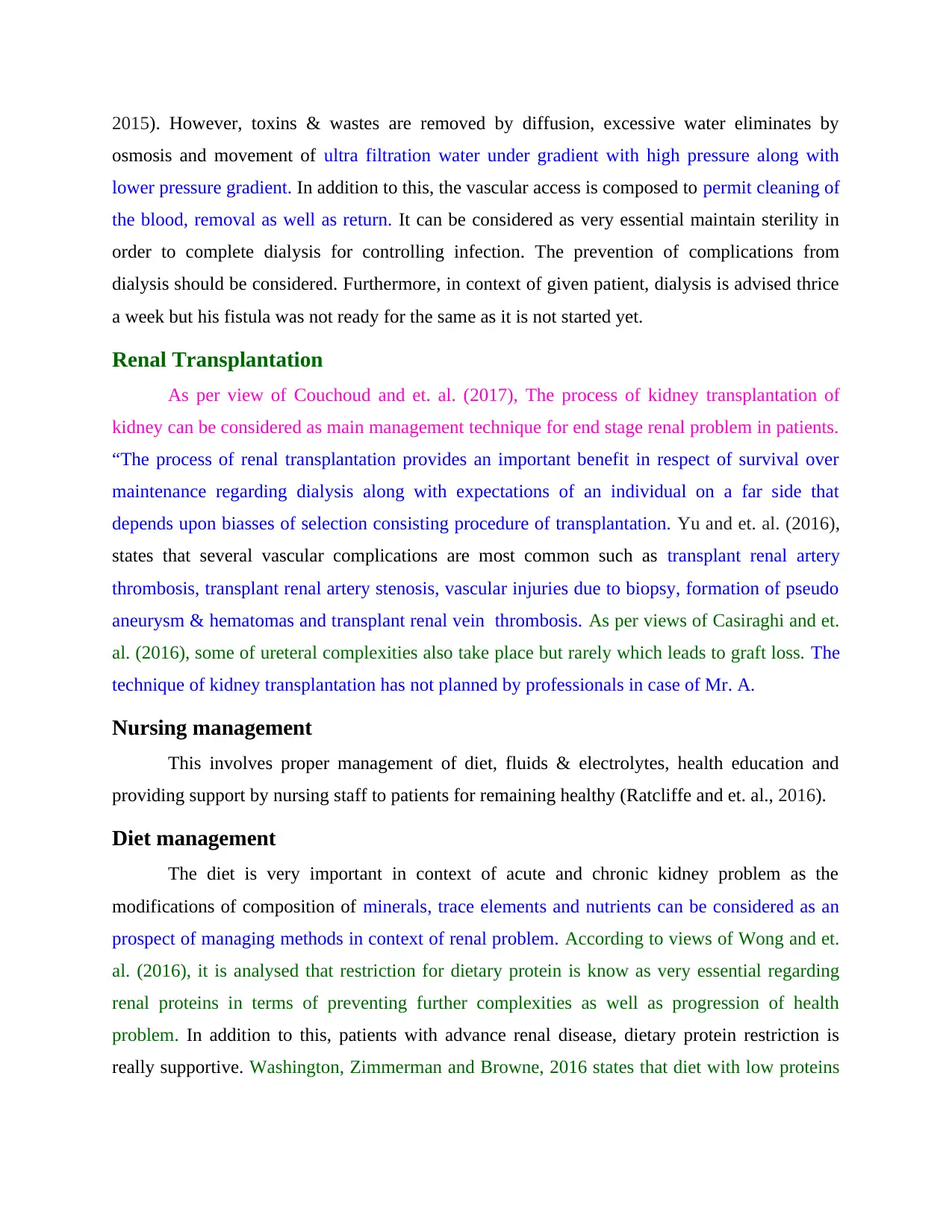
2015). However, toxins & wastes are removed by diffusion, excessive water eliminates by
osmosis and movement of ultra filtration water under gradient with high pressure along with
lower pressure gradient. In addition to this, the vascular access is composed to permit cleaning of
the blood, removal as well as return. It can be considered as very essential maintain sterility in
order to complete dialysis for controlling infection. The prevention of complications from
dialysis should be considered. Furthermore, in context of given patient, dialysis is advised thrice
a week but his fistula was not ready for the same as it is not started yet.
Renal Transplantation
As per view of Couchoud and et. al. (2017), The process of kidney transplantation of
kidney can be considered as main management technique for end stage renal problem in patients.
“The process of renal transplantation provides an important benefit in respect of survival over
maintenance regarding dialysis along with expectations of an individual on a far side that
depends upon biasses of selection consisting procedure of transplantation. Yu and et. al. (2016),
states that several vascular complications are most common such as transplant renal artery
thrombosis, transplant renal artery stenosis, vascular injuries due to biopsy, formation of pseudo
aneurysm & hematomas and transplant renal vein thrombosis. As per views of Casiraghi and et.
al. (2016), some of ureteral complexities also take place but rarely which leads to graft loss. The
technique of kidney transplantation has not planned by professionals in case of Mr. A.
Nursing management
This involves proper management of diet, fluids & electrolytes, health education and
providing support by nursing staff to patients for remaining healthy (Ratcliffe and et. al., 2016).
Diet management
The diet is very important in context of acute and chronic kidney problem as the
modifications of composition of minerals, trace elements and nutrients can be considered as an
prospect of managing methods in context of renal problem. According to views of Wong and et.
al. (2016), it is analysed that restriction for dietary protein is know as very essential regarding
renal proteins in terms of preventing further complexities as well as progression of health
problem. In addition to this, patients with advance renal disease, dietary protein restriction is
really supportive. Washington, Zimmerman and Browne, 2016 states that diet with low proteins
osmosis and movement of ultra filtration water under gradient with high pressure along with
lower pressure gradient. In addition to this, the vascular access is composed to permit cleaning of
the blood, removal as well as return. It can be considered as very essential maintain sterility in
order to complete dialysis for controlling infection. The prevention of complications from
dialysis should be considered. Furthermore, in context of given patient, dialysis is advised thrice
a week but his fistula was not ready for the same as it is not started yet.
Renal Transplantation
As per view of Couchoud and et. al. (2017), The process of kidney transplantation of
kidney can be considered as main management technique for end stage renal problem in patients.
“The process of renal transplantation provides an important benefit in respect of survival over
maintenance regarding dialysis along with expectations of an individual on a far side that
depends upon biasses of selection consisting procedure of transplantation. Yu and et. al. (2016),
states that several vascular complications are most common such as transplant renal artery
thrombosis, transplant renal artery stenosis, vascular injuries due to biopsy, formation of pseudo
aneurysm & hematomas and transplant renal vein thrombosis. As per views of Casiraghi and et.
al. (2016), some of ureteral complexities also take place but rarely which leads to graft loss. The
technique of kidney transplantation has not planned by professionals in case of Mr. A.
Nursing management
This involves proper management of diet, fluids & electrolytes, health education and
providing support by nursing staff to patients for remaining healthy (Ratcliffe and et. al., 2016).
Diet management
The diet is very important in context of acute and chronic kidney problem as the
modifications of composition of minerals, trace elements and nutrients can be considered as an
prospect of managing methods in context of renal problem. According to views of Wong and et.
al. (2016), it is analysed that restriction for dietary protein is know as very essential regarding
renal proteins in terms of preventing further complexities as well as progression of health
problem. In addition to this, patients with advance renal disease, dietary protein restriction is
really supportive. Washington, Zimmerman and Browne, 2016 states that diet with low proteins
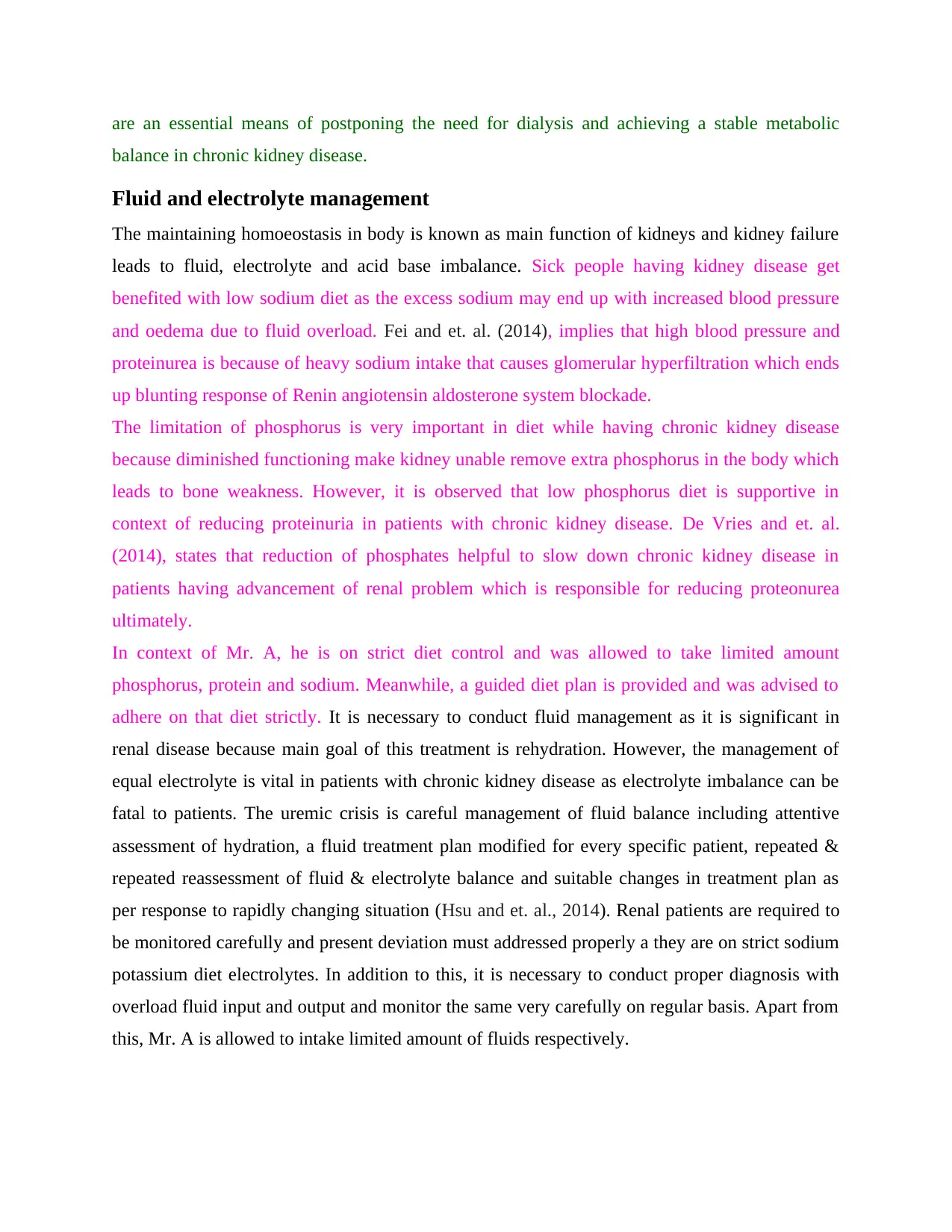
are an essential means of postponing the need for dialysis and achieving a stable metabolic
balance in chronic kidney disease.
Fluid and electrolyte management
The maintaining homoeostasis in body is known as main function of kidneys and kidney failure
leads to fluid, electrolyte and acid base imbalance. Sick people having kidney disease get
benefited with low sodium diet as the excess sodium may end up with increased blood pressure
and oedema due to fluid overload. Fei and et. al. (2014), implies that high blood pressure and
proteinurea is because of heavy sodium intake that causes glomerular hyperfiltration which ends
up blunting response of Renin angiotensin aldosterone system blockade.
The limitation of phosphorus is very important in diet while having chronic kidney disease
because diminished functioning make kidney unable remove extra phosphorus in the body which
leads to bone weakness. However, it is observed that low phosphorus diet is supportive in
context of reducing proteinuria in patients with chronic kidney disease. De Vries and et. al.
(2014), states that reduction of phosphates helpful to slow down chronic kidney disease in
patients having advancement of renal problem which is responsible for reducing proteonurea
ultimately.
In context of Mr. A, he is on strict diet control and was allowed to take limited amount
phosphorus, protein and sodium. Meanwhile, a guided diet plan is provided and was advised to
adhere on that diet strictly. It is necessary to conduct fluid management as it is significant in
renal disease because main goal of this treatment is rehydration. However, the management of
equal electrolyte is vital in patients with chronic kidney disease as electrolyte imbalance can be
fatal to patients. The uremic crisis is careful management of fluid balance including attentive
assessment of hydration, a fluid treatment plan modified for every specific patient, repeated &
repeated reassessment of fluid & electrolyte balance and suitable changes in treatment plan as
per response to rapidly changing situation (Hsu and et. al., 2014). Renal patients are required to
be monitored carefully and present deviation must addressed properly a they are on strict sodium
potassium diet electrolytes. In addition to this, it is necessary to conduct proper diagnosis with
overload fluid input and output and monitor the same very carefully on regular basis. Apart from
this, Mr. A is allowed to intake limited amount of fluids respectively.
balance in chronic kidney disease.
Fluid and electrolyte management
The maintaining homoeostasis in body is known as main function of kidneys and kidney failure
leads to fluid, electrolyte and acid base imbalance. Sick people having kidney disease get
benefited with low sodium diet as the excess sodium may end up with increased blood pressure
and oedema due to fluid overload. Fei and et. al. (2014), implies that high blood pressure and
proteinurea is because of heavy sodium intake that causes glomerular hyperfiltration which ends
up blunting response of Renin angiotensin aldosterone system blockade.
The limitation of phosphorus is very important in diet while having chronic kidney disease
because diminished functioning make kidney unable remove extra phosphorus in the body which
leads to bone weakness. However, it is observed that low phosphorus diet is supportive in
context of reducing proteinuria in patients with chronic kidney disease. De Vries and et. al.
(2014), states that reduction of phosphates helpful to slow down chronic kidney disease in
patients having advancement of renal problem which is responsible for reducing proteonurea
ultimately.
In context of Mr. A, he is on strict diet control and was allowed to take limited amount
phosphorus, protein and sodium. Meanwhile, a guided diet plan is provided and was advised to
adhere on that diet strictly. It is necessary to conduct fluid management as it is significant in
renal disease because main goal of this treatment is rehydration. However, the management of
equal electrolyte is vital in patients with chronic kidney disease as electrolyte imbalance can be
fatal to patients. The uremic crisis is careful management of fluid balance including attentive
assessment of hydration, a fluid treatment plan modified for every specific patient, repeated &
repeated reassessment of fluid & electrolyte balance and suitable changes in treatment plan as
per response to rapidly changing situation (Hsu and et. al., 2014). Renal patients are required to
be monitored carefully and present deviation must addressed properly a they are on strict sodium
potassium diet electrolytes. In addition to this, it is necessary to conduct proper diagnosis with
overload fluid input and output and monitor the same very carefully on regular basis. Apart from
this, Mr. A is allowed to intake limited amount of fluids respectively.
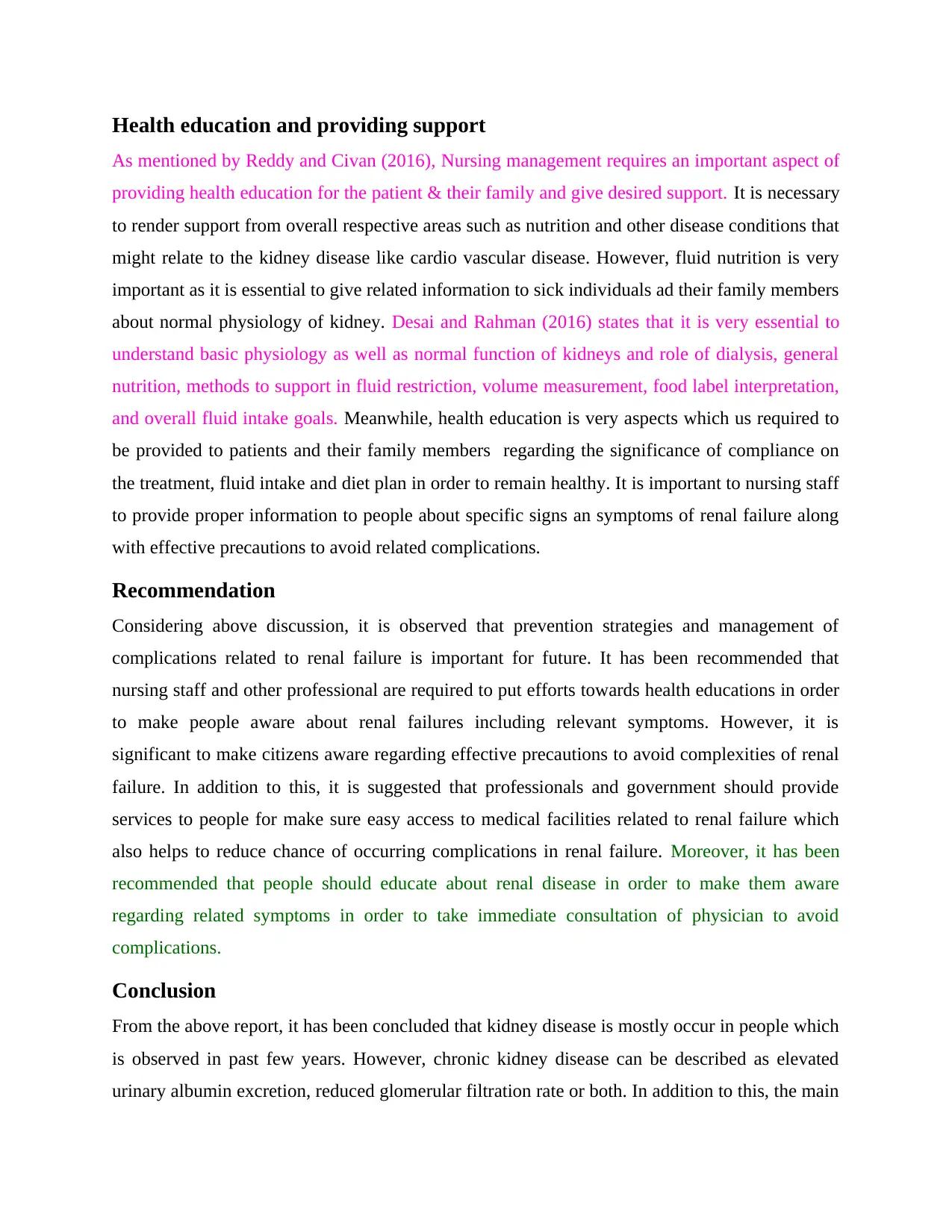
Health education and providing support
As mentioned by Reddy and Civan (2016), Nursing management requires an important aspect of
providing health education for the patient & their family and give desired support. It is necessary
to render support from overall respective areas such as nutrition and other disease conditions that
might relate to the kidney disease like cardio vascular disease. However, fluid nutrition is very
important as it is essential to give related information to sick individuals ad their family members
about normal physiology of kidney. Desai and Rahman (2016) states that it is very essential to
understand basic physiology as well as normal function of kidneys and role of dialysis, general
nutrition, methods to support in fluid restriction, volume measurement, food label interpretation,
and overall fluid intake goals. Meanwhile, health education is very aspects which us required to
be provided to patients and their family members regarding the significance of compliance on
the treatment, fluid intake and diet plan in order to remain healthy. It is important to nursing staff
to provide proper information to people about specific signs an symptoms of renal failure along
with effective precautions to avoid related complications.
Recommendation
Considering above discussion, it is observed that prevention strategies and management of
complications related to renal failure is important for future. It has been recommended that
nursing staff and other professional are required to put efforts towards health educations in order
to make people aware about renal failures including relevant symptoms. However, it is
significant to make citizens aware regarding effective precautions to avoid complexities of renal
failure. In addition to this, it is suggested that professionals and government should provide
services to people for make sure easy access to medical facilities related to renal failure which
also helps to reduce chance of occurring complications in renal failure. Moreover, it has been
recommended that people should educate about renal disease in order to make them aware
regarding related symptoms in order to take immediate consultation of physician to avoid
complications.
Conclusion
From the above report, it has been concluded that kidney disease is mostly occur in people which
is observed in past few years. However, chronic kidney disease can be described as elevated
urinary albumin excretion, reduced glomerular filtration rate or both. In addition to this, the main
As mentioned by Reddy and Civan (2016), Nursing management requires an important aspect of
providing health education for the patient & their family and give desired support. It is necessary
to render support from overall respective areas such as nutrition and other disease conditions that
might relate to the kidney disease like cardio vascular disease. However, fluid nutrition is very
important as it is essential to give related information to sick individuals ad their family members
about normal physiology of kidney. Desai and Rahman (2016) states that it is very essential to
understand basic physiology as well as normal function of kidneys and role of dialysis, general
nutrition, methods to support in fluid restriction, volume measurement, food label interpretation,
and overall fluid intake goals. Meanwhile, health education is very aspects which us required to
be provided to patients and their family members regarding the significance of compliance on
the treatment, fluid intake and diet plan in order to remain healthy. It is important to nursing staff
to provide proper information to people about specific signs an symptoms of renal failure along
with effective precautions to avoid related complications.
Recommendation
Considering above discussion, it is observed that prevention strategies and management of
complications related to renal failure is important for future. It has been recommended that
nursing staff and other professional are required to put efforts towards health educations in order
to make people aware about renal failures including relevant symptoms. However, it is
significant to make citizens aware regarding effective precautions to avoid complexities of renal
failure. In addition to this, it is suggested that professionals and government should provide
services to people for make sure easy access to medical facilities related to renal failure which
also helps to reduce chance of occurring complications in renal failure. Moreover, it has been
recommended that people should educate about renal disease in order to make them aware
regarding related symptoms in order to take immediate consultation of physician to avoid
complications.
Conclusion
From the above report, it has been concluded that kidney disease is mostly occur in people which
is observed in past few years. However, chronic kidney disease can be described as elevated
urinary albumin excretion, reduced glomerular filtration rate or both. In addition to this, the main
Secure Best Marks with AI Grader
Need help grading? Try our AI Grader for instant feedback on your assignments.
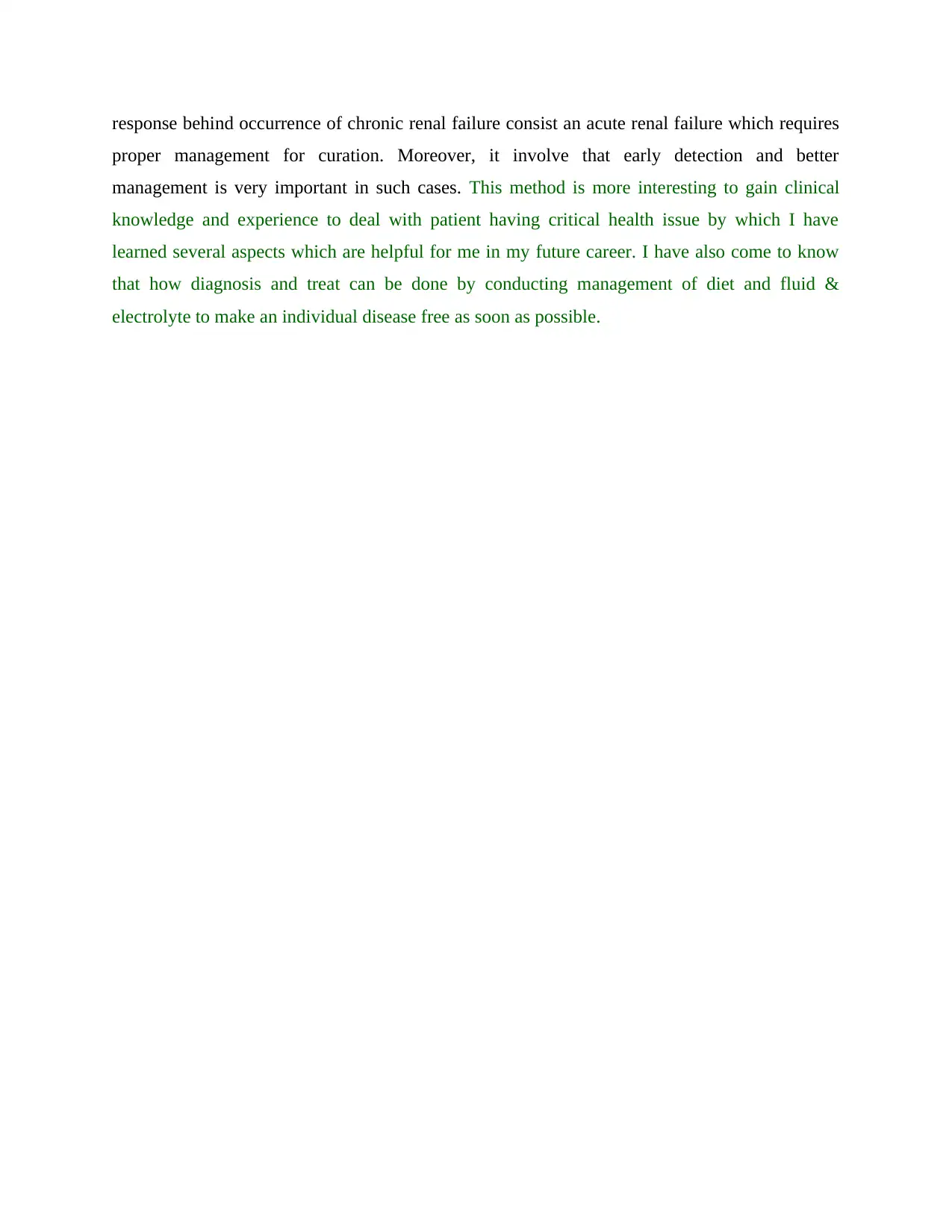
response behind occurrence of chronic renal failure consist an acute renal failure which requires
proper management for curation. Moreover, it involve that early detection and better
management is very important in such cases. This method is more interesting to gain clinical
knowledge and experience to deal with patient having critical health issue by which I have
learned several aspects which are helpful for me in my future career. I have also come to know
that how diagnosis and treat can be done by conducting management of diet and fluid &
electrolyte to make an individual disease free as soon as possible.
proper management for curation. Moreover, it involve that early detection and better
management is very important in such cases. This method is more interesting to gain clinical
knowledge and experience to deal with patient having critical health issue by which I have
learned several aspects which are helpful for me in my future career. I have also come to know
that how diagnosis and treat can be done by conducting management of diet and fluid &
electrolyte to make an individual disease free as soon as possible.

References
Babitt, J.,L. and Lin, H.,Y. (2012) Mechanism of Anemia in Ckd. Journal of the American
Society of Nephrology[online]. 23 (10), pp. 1631-1634. [Accessed 17 January 2019].
Helal, I., Brosnahan, G.,M.,F., Gitomer, B.,R. and Schrier, R.,W. (2012) Glomerular
Hyperfiltration: Definitions, Mechanisms and Clinical Implications. Nature Review
Nephrology [online]. 8, pp. 293-300. [Accessed 17 January 2019].
James, M.,T., Hemmelgarn, B.,R. and Tonelli, M. (2010) Early Recognition and Prevention of
Chronic Kidney Disease. The Lancet [online]. 375 (9722), p. 1226. [Accessed 17 January 2019].
Lorio, B.,R.,D., Belizzi, V., Bellasi, A., Torraca, S., D'arriogo, G., Tripepi, G. and Zoccali, C.
(2013) Phosphate Attenuates the Anti-proteinuric Effect of Very Low-protein Diet in Ckd
Patients. Nephrology Dialysis Transplantation [online]. 28 (3), pp. 632-640. [Accessed 17
January 2019].
Palatini, P., Casiglia, E., Gasowski, J., Gluszek, J., Jankowski, P., Narkiewicz, K., Saladini, F.,
Skrzypek, K.,S., Tikhonoff, V., Bortel, L.,V., Wojciechowska, W. and Jaszcz, K.,K. (2011)
Arterial Stiffness, Central Hemodynamics, and Cardiovascular Risk in Hypertension. Vascular
Health Risk Management [online]. 7, pp. 725-739. [Accessed 17 January 2019]
Ruggenenti, P., Cravedi, P. and Remuzzi, G. (2012) Mechanism and Treatment of Ckd. Journal
of American Society of Nephrology [online]. 23 (12), pp. 1917-1923. [Accessed 17 January
2019].
Se Won Oh, and Sang Youb Han, (2015) Loop Diuretics in Clinical Practice. Electrolyte Blood
Press [online]. 13 (1), pp. 17-21. [Accessed 17 January 2019].
Pena, M. J., Lambers Heerspink, H. J., Hellemons, M. E., Friedrich, T., Dallmann, G., Lajer,
M., ... and Roscioni, S. S. (2014). Urine and plasma metabolites predict the development of
diabetic nephropathy in individuals with Type 2 diabetes mellitus. Diabetic Medicine. [Online].
31(9), 1138-1147. [Accessed on 17 January 2019].
De Vries, A. P., Ruggenenti, P., Ruan, X. Z., Praga, M., Cruzado, J. M., Bajema, I. M., ... and
Abbate, M. (2014). Fatty kidney: emerging role of ectopic lipid in obesity-related renal
disease. The lancet Diabetes & endocrinology. [online]. 2(5), 417-426. [Accessed on 17 January
2019].
Fei, Y., Shi, X., Gan, F., Li, X., Zhang, W., Li, M., ... and Zhang, F. (2014). Death causes and
pathogens analysis of systemic lupus erythematosus during the past 26 years. Clinical
rheumatology. [online]. 33(1), 57-63. [Accessed on 17 January 2019].
Yu, T. M., Chuang, Y. W., Yu, M. C., Chen, C. H., Yang, C. K., Huang, S. T., .. and Kao, C. H.
(2016). Risk of cancer in patients with polycystic kidney disease: a propensity-score matched
analysis of a nationwide, population-based cohort study. The Lancet Oncology. [online]. 17(10),
1419-1425. [Accessed on 17 January 2019].
Liu, P., Chen, Y., Wang, B., Zhang, F., Wang, D., and Wang, Y. (2015). Allopurinol treatment
improves renal function in patients with type 2 diabetes and asymptomatic hyperuricemia: 3‐year
randomized parallel‐controlled study. Clinical endocrinology. [online]. 83(4), 475-482.
[Accessed on 17 January 2019].
Mancia, G., Fagard, R., Narkiewicz, K., Redon, J., Zanchetti, A., Böhm, M., ... and Galderisi, M.
(2014). 2013 ESH/ESC Practice guidelines for the management of arterial hypertension: ESH-
ESC The Task Force for the management of arterial hypertension of the European Society of
Hypertension (ESH) and of the European Society of Cardiology (ESC). Blood pressure. [online].
23(1), 3-16. [Accessed on 17 January 2019].
Babitt, J.,L. and Lin, H.,Y. (2012) Mechanism of Anemia in Ckd. Journal of the American
Society of Nephrology[online]. 23 (10), pp. 1631-1634. [Accessed 17 January 2019].
Helal, I., Brosnahan, G.,M.,F., Gitomer, B.,R. and Schrier, R.,W. (2012) Glomerular
Hyperfiltration: Definitions, Mechanisms and Clinical Implications. Nature Review
Nephrology [online]. 8, pp. 293-300. [Accessed 17 January 2019].
James, M.,T., Hemmelgarn, B.,R. and Tonelli, M. (2010) Early Recognition and Prevention of
Chronic Kidney Disease. The Lancet [online]. 375 (9722), p. 1226. [Accessed 17 January 2019].
Lorio, B.,R.,D., Belizzi, V., Bellasi, A., Torraca, S., D'arriogo, G., Tripepi, G. and Zoccali, C.
(2013) Phosphate Attenuates the Anti-proteinuric Effect of Very Low-protein Diet in Ckd
Patients. Nephrology Dialysis Transplantation [online]. 28 (3), pp. 632-640. [Accessed 17
January 2019].
Palatini, P., Casiglia, E., Gasowski, J., Gluszek, J., Jankowski, P., Narkiewicz, K., Saladini, F.,
Skrzypek, K.,S., Tikhonoff, V., Bortel, L.,V., Wojciechowska, W. and Jaszcz, K.,K. (2011)
Arterial Stiffness, Central Hemodynamics, and Cardiovascular Risk in Hypertension. Vascular
Health Risk Management [online]. 7, pp. 725-739. [Accessed 17 January 2019]
Ruggenenti, P., Cravedi, P. and Remuzzi, G. (2012) Mechanism and Treatment of Ckd. Journal
of American Society of Nephrology [online]. 23 (12), pp. 1917-1923. [Accessed 17 January
2019].
Se Won Oh, and Sang Youb Han, (2015) Loop Diuretics in Clinical Practice. Electrolyte Blood
Press [online]. 13 (1), pp. 17-21. [Accessed 17 January 2019].
Pena, M. J., Lambers Heerspink, H. J., Hellemons, M. E., Friedrich, T., Dallmann, G., Lajer,
M., ... and Roscioni, S. S. (2014). Urine and plasma metabolites predict the development of
diabetic nephropathy in individuals with Type 2 diabetes mellitus. Diabetic Medicine. [Online].
31(9), 1138-1147. [Accessed on 17 January 2019].
De Vries, A. P., Ruggenenti, P., Ruan, X. Z., Praga, M., Cruzado, J. M., Bajema, I. M., ... and
Abbate, M. (2014). Fatty kidney: emerging role of ectopic lipid in obesity-related renal
disease. The lancet Diabetes & endocrinology. [online]. 2(5), 417-426. [Accessed on 17 January
2019].
Fei, Y., Shi, X., Gan, F., Li, X., Zhang, W., Li, M., ... and Zhang, F. (2014). Death causes and
pathogens analysis of systemic lupus erythematosus during the past 26 years. Clinical
rheumatology. [online]. 33(1), 57-63. [Accessed on 17 January 2019].
Yu, T. M., Chuang, Y. W., Yu, M. C., Chen, C. H., Yang, C. K., Huang, S. T., .. and Kao, C. H.
(2016). Risk of cancer in patients with polycystic kidney disease: a propensity-score matched
analysis of a nationwide, population-based cohort study. The Lancet Oncology. [online]. 17(10),
1419-1425. [Accessed on 17 January 2019].
Liu, P., Chen, Y., Wang, B., Zhang, F., Wang, D., and Wang, Y. (2015). Allopurinol treatment
improves renal function in patients with type 2 diabetes and asymptomatic hyperuricemia: 3‐year
randomized parallel‐controlled study. Clinical endocrinology. [online]. 83(4), 475-482.
[Accessed on 17 January 2019].
Mancia, G., Fagard, R., Narkiewicz, K., Redon, J., Zanchetti, A., Böhm, M., ... and Galderisi, M.
(2014). 2013 ESH/ESC Practice guidelines for the management of arterial hypertension: ESH-
ESC The Task Force for the management of arterial hypertension of the European Society of
Hypertension (ESH) and of the European Society of Cardiology (ESC). Blood pressure. [online].
23(1), 3-16. [Accessed on 17 January 2019].
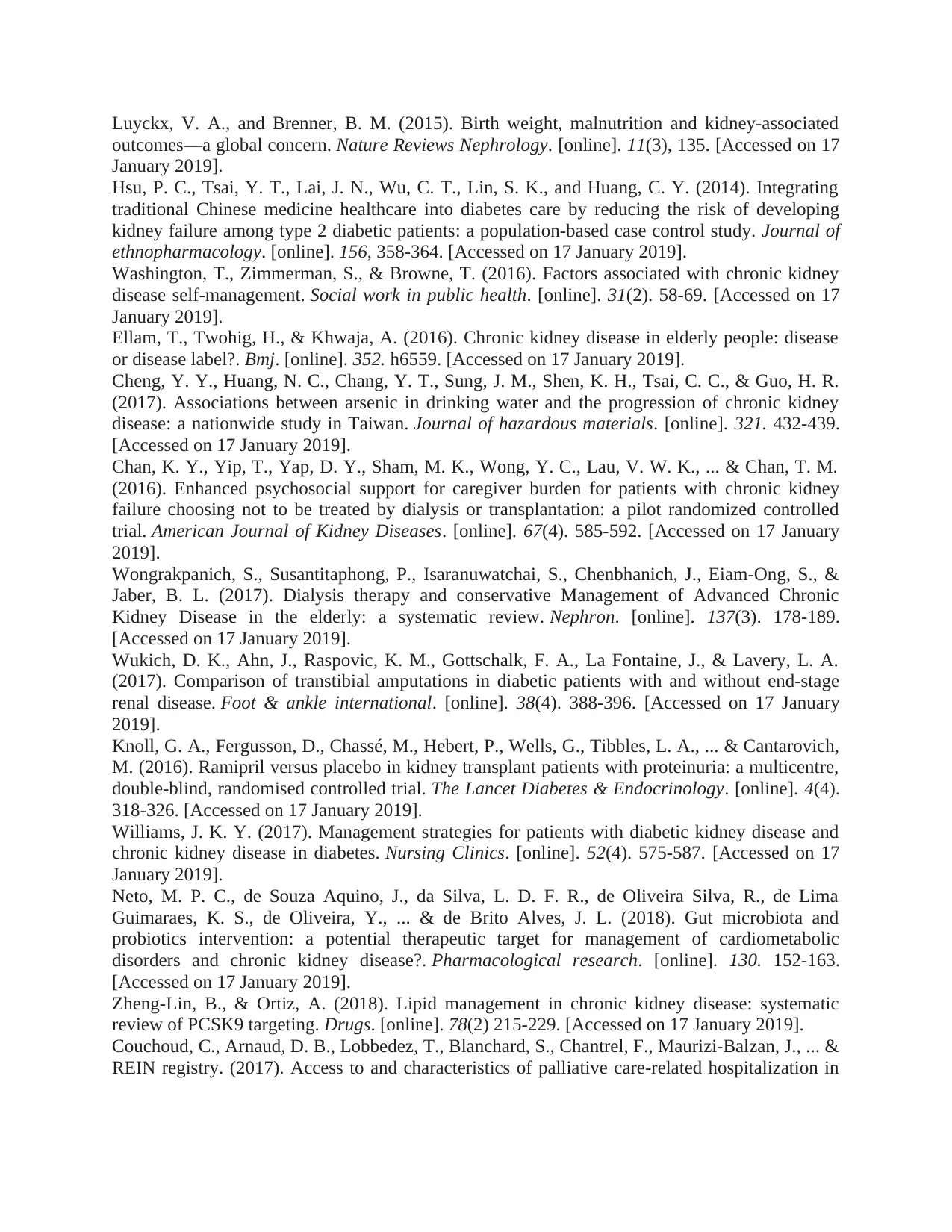
Luyckx, V. A., and Brenner, B. M. (2015). Birth weight, malnutrition and kidney-associated
outcomes—a global concern. Nature Reviews Nephrology. [online]. 11(3), 135. [Accessed on 17
January 2019].
Hsu, P. C., Tsai, Y. T., Lai, J. N., Wu, C. T., Lin, S. K., and Huang, C. Y. (2014). Integrating
traditional Chinese medicine healthcare into diabetes care by reducing the risk of developing
kidney failure among type 2 diabetic patients: a population-based case control study. Journal of
ethnopharmacology. [online]. 156, 358-364. [Accessed on 17 January 2019].
Washington, T., Zimmerman, S., & Browne, T. (2016). Factors associated with chronic kidney
disease self-management. Social work in public health. [online]. 31(2). 58-69. [Accessed on 17
January 2019].
Ellam, T., Twohig, H., & Khwaja, A. (2016). Chronic kidney disease in elderly people: disease
or disease label?. Bmj. [online]. 352. h6559. [Accessed on 17 January 2019].
Cheng, Y. Y., Huang, N. C., Chang, Y. T., Sung, J. M., Shen, K. H., Tsai, C. C., & Guo, H. R.
(2017). Associations between arsenic in drinking water and the progression of chronic kidney
disease: a nationwide study in Taiwan. Journal of hazardous materials. [online]. 321. 432-439.
[Accessed on 17 January 2019].
Chan, K. Y., Yip, T., Yap, D. Y., Sham, M. K., Wong, Y. C., Lau, V. W. K., ... & Chan, T. M.
(2016). Enhanced psychosocial support for caregiver burden for patients with chronic kidney
failure choosing not to be treated by dialysis or transplantation: a pilot randomized controlled
trial. American Journal of Kidney Diseases. [online]. 67(4). 585-592. [Accessed on 17 January
2019].
Wongrakpanich, S., Susantitaphong, P., Isaranuwatchai, S., Chenbhanich, J., Eiam-Ong, S., &
Jaber, B. L. (2017). Dialysis therapy and conservative Management of Advanced Chronic
Kidney Disease in the elderly: a systematic review. Nephron. [online]. 137(3). 178-189.
[Accessed on 17 January 2019].
Wukich, D. K., Ahn, J., Raspovic, K. M., Gottschalk, F. A., La Fontaine, J., & Lavery, L. A.
(2017). Comparison of transtibial amputations in diabetic patients with and without end-stage
renal disease. Foot & ankle international. [online]. 38(4). 388-396. [Accessed on 17 January
2019].
Knoll, G. A., Fergusson, D., Chassé, M., Hebert, P., Wells, G., Tibbles, L. A., ... & Cantarovich,
M. (2016). Ramipril versus placebo in kidney transplant patients with proteinuria: a multicentre,
double-blind, randomised controlled trial. The Lancet Diabetes & Endocrinology. [online]. 4(4).
318-326. [Accessed on 17 January 2019].
Williams, J. K. Y. (2017). Management strategies for patients with diabetic kidney disease and
chronic kidney disease in diabetes. Nursing Clinics. [online]. 52(4). 575-587. [Accessed on 17
January 2019].
Neto, M. P. C., de Souza Aquino, J., da Silva, L. D. F. R., de Oliveira Silva, R., de Lima
Guimaraes, K. S., de Oliveira, Y., ... & de Brito Alves, J. L. (2018). Gut microbiota and
probiotics intervention: a potential therapeutic target for management of cardiometabolic
disorders and chronic kidney disease?. Pharmacological research. [online]. 130. 152-163.
[Accessed on 17 January 2019].
Zheng-Lin, B., & Ortiz, A. (2018). Lipid management in chronic kidney disease: systematic
review of PCSK9 targeting. Drugs. [online]. 78(2) 215-229. [Accessed on 17 January 2019].
Couchoud, C., Arnaud, D. B., Lobbedez, T., Blanchard, S., Chantrel, F., Maurizi‐Balzan, J., ... &
REIN registry. (2017). Access to and characteristics of palliative care‐related hospitalization in
outcomes—a global concern. Nature Reviews Nephrology. [online]. 11(3), 135. [Accessed on 17
January 2019].
Hsu, P. C., Tsai, Y. T., Lai, J. N., Wu, C. T., Lin, S. K., and Huang, C. Y. (2014). Integrating
traditional Chinese medicine healthcare into diabetes care by reducing the risk of developing
kidney failure among type 2 diabetic patients: a population-based case control study. Journal of
ethnopharmacology. [online]. 156, 358-364. [Accessed on 17 January 2019].
Washington, T., Zimmerman, S., & Browne, T. (2016). Factors associated with chronic kidney
disease self-management. Social work in public health. [online]. 31(2). 58-69. [Accessed on 17
January 2019].
Ellam, T., Twohig, H., & Khwaja, A. (2016). Chronic kidney disease in elderly people: disease
or disease label?. Bmj. [online]. 352. h6559. [Accessed on 17 January 2019].
Cheng, Y. Y., Huang, N. C., Chang, Y. T., Sung, J. M., Shen, K. H., Tsai, C. C., & Guo, H. R.
(2017). Associations between arsenic in drinking water and the progression of chronic kidney
disease: a nationwide study in Taiwan. Journal of hazardous materials. [online]. 321. 432-439.
[Accessed on 17 January 2019].
Chan, K. Y., Yip, T., Yap, D. Y., Sham, M. K., Wong, Y. C., Lau, V. W. K., ... & Chan, T. M.
(2016). Enhanced psychosocial support for caregiver burden for patients with chronic kidney
failure choosing not to be treated by dialysis or transplantation: a pilot randomized controlled
trial. American Journal of Kidney Diseases. [online]. 67(4). 585-592. [Accessed on 17 January
2019].
Wongrakpanich, S., Susantitaphong, P., Isaranuwatchai, S., Chenbhanich, J., Eiam-Ong, S., &
Jaber, B. L. (2017). Dialysis therapy and conservative Management of Advanced Chronic
Kidney Disease in the elderly: a systematic review. Nephron. [online]. 137(3). 178-189.
[Accessed on 17 January 2019].
Wukich, D. K., Ahn, J., Raspovic, K. M., Gottschalk, F. A., La Fontaine, J., & Lavery, L. A.
(2017). Comparison of transtibial amputations in diabetic patients with and without end-stage
renal disease. Foot & ankle international. [online]. 38(4). 388-396. [Accessed on 17 January
2019].
Knoll, G. A., Fergusson, D., Chassé, M., Hebert, P., Wells, G., Tibbles, L. A., ... & Cantarovich,
M. (2016). Ramipril versus placebo in kidney transplant patients with proteinuria: a multicentre,
double-blind, randomised controlled trial. The Lancet Diabetes & Endocrinology. [online]. 4(4).
318-326. [Accessed on 17 January 2019].
Williams, J. K. Y. (2017). Management strategies for patients with diabetic kidney disease and
chronic kidney disease in diabetes. Nursing Clinics. [online]. 52(4). 575-587. [Accessed on 17
January 2019].
Neto, M. P. C., de Souza Aquino, J., da Silva, L. D. F. R., de Oliveira Silva, R., de Lima
Guimaraes, K. S., de Oliveira, Y., ... & de Brito Alves, J. L. (2018). Gut microbiota and
probiotics intervention: a potential therapeutic target for management of cardiometabolic
disorders and chronic kidney disease?. Pharmacological research. [online]. 130. 152-163.
[Accessed on 17 January 2019].
Zheng-Lin, B., & Ortiz, A. (2018). Lipid management in chronic kidney disease: systematic
review of PCSK9 targeting. Drugs. [online]. 78(2) 215-229. [Accessed on 17 January 2019].
Couchoud, C., Arnaud, D. B., Lobbedez, T., Blanchard, S., Chantrel, F., Maurizi‐Balzan, J., ... &
REIN registry. (2017). Access to and characteristics of palliative care‐related hospitalization in
Paraphrase This Document
Need a fresh take? Get an instant paraphrase of this document with our AI Paraphraser
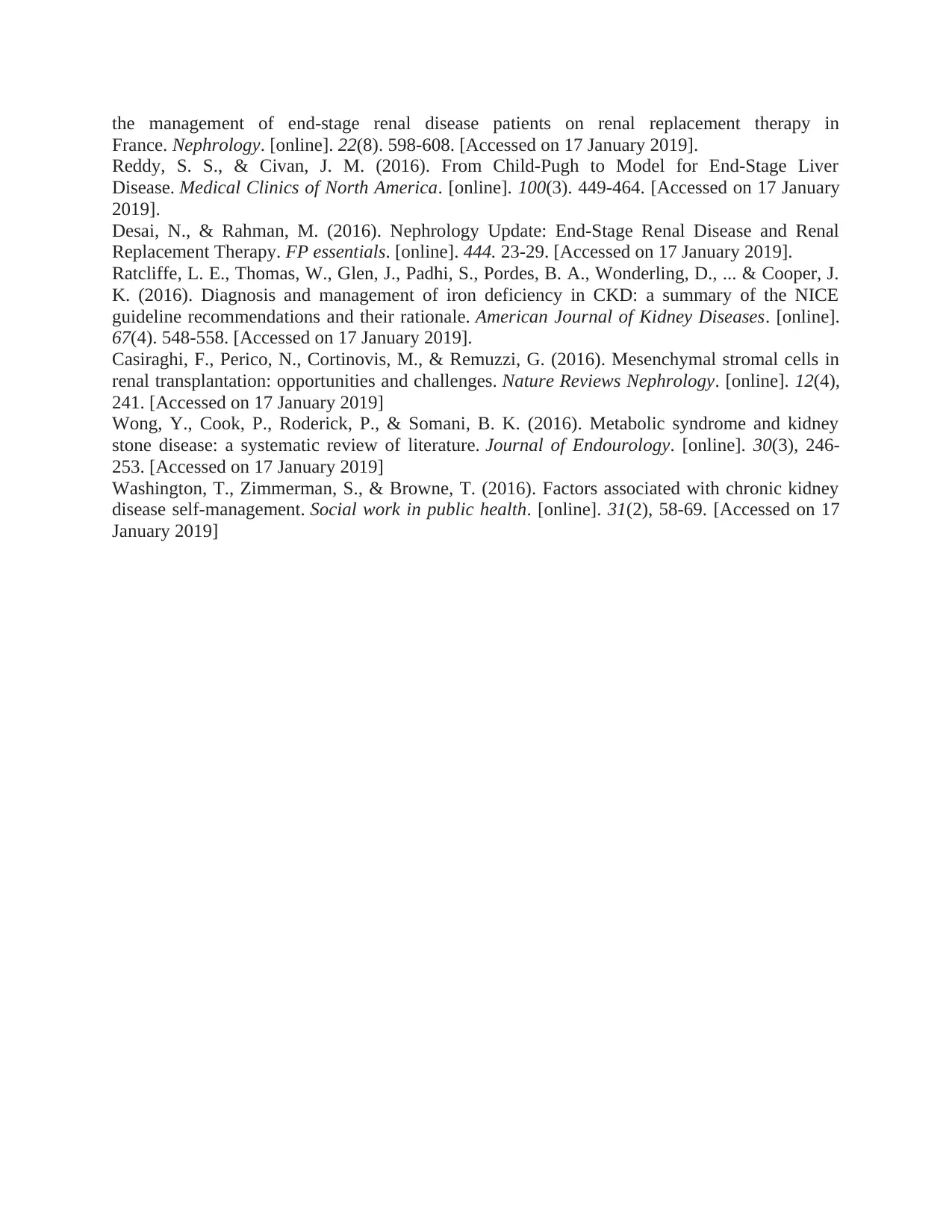
the management of end‐stage renal disease patients on renal replacement therapy in
France. Nephrology. [online]. 22(8). 598-608. [Accessed on 17 January 2019].
Reddy, S. S., & Civan, J. M. (2016). From Child-Pugh to Model for End-Stage Liver
Disease. Medical Clinics of North America. [online]. 100(3). 449-464. [Accessed on 17 January
2019].
Desai, N., & Rahman, M. (2016). Nephrology Update: End-Stage Renal Disease and Renal
Replacement Therapy. FP essentials. [online]. 444. 23-29. [Accessed on 17 January 2019].
Ratcliffe, L. E., Thomas, W., Glen, J., Padhi, S., Pordes, B. A., Wonderling, D., ... & Cooper, J.
K. (2016). Diagnosis and management of iron deficiency in CKD: a summary of the NICE
guideline recommendations and their rationale. American Journal of Kidney Diseases. [online].
67(4). 548-558. [Accessed on 17 January 2019].
Casiraghi, F., Perico, N., Cortinovis, M., & Remuzzi, G. (2016). Mesenchymal stromal cells in
renal transplantation: opportunities and challenges. Nature Reviews Nephrology. [online]. 12(4),
241. [Accessed on 17 January 2019]
Wong, Y., Cook, P., Roderick, P., & Somani, B. K. (2016). Metabolic syndrome and kidney
stone disease: a systematic review of literature. Journal of Endourology. [online]. 30(3), 246-
253. [Accessed on 17 January 2019]
Washington, T., Zimmerman, S., & Browne, T. (2016). Factors associated with chronic kidney
disease self-management. Social work in public health. [online]. 31(2), 58-69. [Accessed on 17
January 2019]
France. Nephrology. [online]. 22(8). 598-608. [Accessed on 17 January 2019].
Reddy, S. S., & Civan, J. M. (2016). From Child-Pugh to Model for End-Stage Liver
Disease. Medical Clinics of North America. [online]. 100(3). 449-464. [Accessed on 17 January
2019].
Desai, N., & Rahman, M. (2016). Nephrology Update: End-Stage Renal Disease and Renal
Replacement Therapy. FP essentials. [online]. 444. 23-29. [Accessed on 17 January 2019].
Ratcliffe, L. E., Thomas, W., Glen, J., Padhi, S., Pordes, B. A., Wonderling, D., ... & Cooper, J.
K. (2016). Diagnosis and management of iron deficiency in CKD: a summary of the NICE
guideline recommendations and their rationale. American Journal of Kidney Diseases. [online].
67(4). 548-558. [Accessed on 17 January 2019].
Casiraghi, F., Perico, N., Cortinovis, M., & Remuzzi, G. (2016). Mesenchymal stromal cells in
renal transplantation: opportunities and challenges. Nature Reviews Nephrology. [online]. 12(4),
241. [Accessed on 17 January 2019]
Wong, Y., Cook, P., Roderick, P., & Somani, B. K. (2016). Metabolic syndrome and kidney
stone disease: a systematic review of literature. Journal of Endourology. [online]. 30(3), 246-
253. [Accessed on 17 January 2019]
Washington, T., Zimmerman, S., & Browne, T. (2016). Factors associated with chronic kidney
disease self-management. Social work in public health. [online]. 31(2), 58-69. [Accessed on 17
January 2019]
1 out of 14
Related Documents
Your All-in-One AI-Powered Toolkit for Academic Success.
+13062052269
info@desklib.com
Available 24*7 on WhatsApp / Email
![[object Object]](/_next/static/media/star-bottom.7253800d.svg)
Unlock your academic potential
© 2024 | Zucol Services PVT LTD | All rights reserved.





